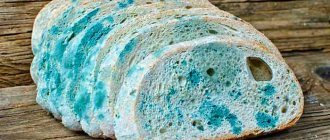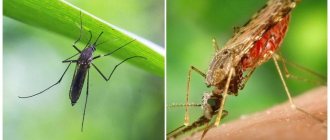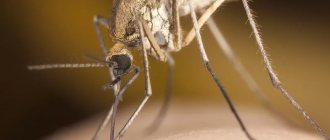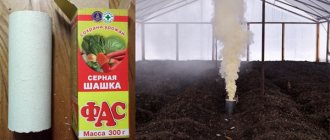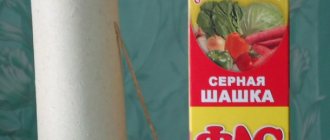Mold that suddenly appears on food can ruin any appetite. It brings with it a lot of troubles: food ceases to be suitable for eating, becomes tasteless and dangerous to health.
The occurrence of mold is associated with violation of the terms and rules of food storage. In such a situation, it is difficult to keep food, be it bread, sausage or dried fruit, in order. Over time, the growth of the fungus accelerates and mold covers the entire surface of the product; this process occurs the faster, the more favorable the environment for its development.
Factors contributing to mold growth:
- increased moisture levels;
- warm;
- air stagnation.
Even if you remove some of the moldy product, it will still remain contaminated.
Even without visible signs, it should not be eaten in any case. Many types of mold have been studied in the world, some of them are harmless (subject to certain conditions), some are extremely dangerous, and some can cause allergic reactions.
Mold can be:
- white (most often occurs on wooden surfaces);
- black (extremely hazardous to health);
- green;
- pink;
- gray.
What to do if you find a moldy product
Every housewife who discovers unpleasant fungal growths on food products immediately asks the question: what to do with them? There are a lot of options: some advise to digest the product, others to boil it for an hour, others to remove the damaged areas, and others to throw away everything at once. What to do?
Some experts offer this solution to the problem, based on two factors:
- Humidity
- Density.
For example, hard cheeses have a fairly dense texture, which prevents spores from penetrating deep into the product. In this case, you can cut off the damaged area and some part around it and throw it away; the rest of the cheese can be eaten without fear.
It is worth noting that some products that are slightly beginning to form mold require immediate disposal. For example, dairy yoghurts or baked goods. The thing is that traces of fungus in this case are only an external manifestation of the problem. There is no doubt that the entire product is contaminated and poses a potential health hazard.
If you find a product with mold, you should do the right thing:
- boiled sausages or boiled meat - definitely throw it in the trash, because fungal spores are found not only outside, but also inside such products;
- dried meat, uncooked smoked products - you can leave them, mold does not harm them;
- dairy, bread products, legumes, cereals, vegetables and fruits (soft consistency), jams should be thrown away;
- Hard cheeses can be left only after first cutting off the layer of fungus and repackaging them for storage.
You should not even smell foods covered with fungus, because spores tend to rise into the air and enter the human respiratory system.
Treatment methods
Failure to provide assistance in a timely manner can lead to poisoning of the body with mycoses. Diagnosing the cause of poisoning is possible only based on the results of laboratory tests. In order to eliminate the risk of developing severe complications, at the first sign of illness with suspected mycosis, you should immediately consult a doctor and begin a course of treatment. As a rule, treatment consists of several stages:
- Antifungal medications.
- Maintenance therapy aimed at normalizing the functioning of the liver and kidneys;
- Restoration of natural microflora in the intestines.
The patient is also recommended to adhere to a diet for some time, which consists of excluding: yeast-based bakery products;
- dried fruits;
- sugar-containing products (desserts);
- fermented milk products;
- some vegetables - beets, potatoes;
- cereals (except pearl barley and buckwheat porridge);
- hard cheeses;
- berries, fruits.
In this case, you need to introduce the following foods into your regular daily diet:
Read also: Metabolic disorders
- ginger, horseradish, radish, onion, garlic;
- infusions and teas containing pine needles or resin;
- pickles;
- inhalations with tea tree oil and pine needles;
- honey;
- mineral water;
- sour berries (dogwood, currants, cranberries, lingonberries, sea buckthorn);
- grape, apple cider vinegar - one and a half teaspoons throughout the day;
- organic antioxidants.
A complete and rapid recovery can only be achieved with an integrated approach to the treatment of mycosis, that is, a combination of medication and adherence to the prescribed diet. But even if you follow all the doctor’s recommendations, treatment can last from six months to 3 years.
Is it possible for children, pregnant and lactating women to eat foods with mold?
Products on which mold has left its mark are not suitable for consumption by children, pregnant women, and nursing mothers. Most likely, nothing will happen from one piece of moldy bread, however, it is better to play it safe and not eat such food.
In addition, there is a high probability that the fungal stain on the fruit or sausage has long gone under the peel and spread throughout the entire product, without visible signs. And this is already fraught with serious poisoning, especially for children and pregnant women, who are very susceptible to all kinds of harmful substances. The same applies to dairy products, a small spot of mold on which already indicates a serious potential danger.
Precautionary measures
Following simple rules will allow you to avoid poisoning from moldy bread:
- It is advisable to buy bakery products in well-established retail outlets; it is better if the product is manufactured by a large bakery,
- It is advisable not to buy bread packaged in film - it creates ideal conditions for the development of mold (high temperature and humidity),
- You should only purchase bakery products whose packaging indicates the production time, expiration date, information about the manufacturer, composition, and product certification information. The composition of the loaf will tell you about the use of harmful additives - L-ascorbic acid (E300) speeds up the proofing time, L-cysteine (E920) improves the structure of the dough, sulfur dioxide (E220) slows down the growth of mold, which often indicates the addition of the remains of an old moldy loaf,
- You shouldn’t buy bread in reserve,
- It is better to store the loaf in a bread box, preferably a wooden one.
Is it possible to eat jam and jams with mold?
It is not uncommon for raspberry jam stored in the refrigerator for a long time to become covered with fungal spores. This is due to the fact that the air is always saturated with mold spores, and a jar of jam, in which the air and humid environment stagnates, becomes an ideal object for their colonization.
A jar that has been left open for 1-2 weeks may well end up covered inside with a pinkish-gray coating that kills any desire to enjoy the product. Strawberry or cherry jam - it doesn’t matter if there is even a drop of mold on it, it needs to be thrown away and cannot be eaten. This food becomes harmful to the very bottom, because spores develop and germinate throughout the product.
As a last resort, if the jam has just started to deteriorate and it’s a shame to part with it, you can try this way to save it:
- remove the top layer of plaque;
- discard 1–2 cm of clean jam;
- transfer the jam to a clean saucepan and boil until the foam disappears;
- foam that appears during boiling must be thrown away;
- then you need to put the jam in a bowl that has been previously treated with boiling water;
- You need to eat this product within 2 days.
Under no circumstances should such jam be given to children, even a small amount, so as not to harm their health. In addition, it is important to ensure that the child does not accidentally eat even a little dangerous product.
What happens if you eat moldy bread?
Bread may develop a coating already 2-3 days after baking. The following factors contribute to this:
- Improper storage of the product, namely a humid environment with high air temperatures. In this case, fungal spores rapidly multiply and spread.
- Violation of certain standards during the preparation of bread (for example, insufficient baking).
- Mold on bread can occur if, during its preparation, an expired and ground product was added to the flour.
What happens if you eat moldy bread? Some people are of the opinion that penicillin in the fungus is even beneficial and regularly eat spoiled bread. This opinion is wrong; it is not capable of bringing a single drop of benefit, but there is plenty of harm.
Features of bread contamination with mold:
- black and green mold are equally dangerous, even if you cut off its visible area;
- the fungus can be inhaled, which leads to the development of pneumonia and other problems with the respiratory system;
- a pink coating may appear on such products; it is caused by wheat infected with potato disease;
- Eating such bread leads to various types of allergic manifestations and food poisoning.
In order to protect yourself and your loved ones from the danger of mold on bread, you need to:
- Do not eat affected bread under any circumstances;
- purchase bread at certified points of sale from trusted manufacturers;
- Store purchased bread in places where it is dry and cool.
Types of bread mold and why it is dangerous
Mold that has settled on bread is classified as a certain organism - fungi. The fungus is very dangerous for humans. If people think that by cutting off the crusts from bread that have mold, the rest of the product can be used, this opinion is wrong. The health of a person who has eaten such bread is at risk, since the fungal spore spreads throughout the baked product. The consequences can be dire. Mold is found in human everyday life, especially often it can be seen on bread. The color of mold can indicate its danger to the body.
- Pink mold
on bread is considered the most harmless. Most often it can be found on grocery, bakery and vegetable scraps. - Black mold,
after entering the human body, can provoke severe intestinal intoxication. - Green mold
on bread, once it enters the body, can cause second-degree poisoning. Most often, intoxication is observed in the digestive and respiratory organs. - White mold
contributes to the production of mycotoxins, which provoke an outbreak of respiratory diseases, allergic reactions, and very rarely death. This is the most common type of mold. - Yellow mold
on bread, after penetrating the intestines, produces aflatoxin, which leads to the development of an oncological process in the human body. - Orange mold
is very poisonous to the human body, in some cases, in people, after eating baked goods with orange mold, the functioning of the kidneys and liver stops.
Scientists say that some types of mold still benefit people. For example, the fungus penicillum (penicillum) is used in medicine; antibiotic medicines are produced from it. Mucor mold is no less useful - in China soy cheese is made from it. Mucor mushroom is used in the fight against rodents and insects.
Is it possible to eat fruits, dried fruits, and moldy vegetables?
Dried fruits and various nuts are extremely healthy food, rich in vitamins and microelements. However, improper storage of them can contribute to the development of dangerous bacteria - aflatoxin. This is a powerful carcinogen that can negatively affect the human body.
A sign of the presence of this toxin in dried fruits may be the formation of mold. Aflatoxins are very dangerous:
- spread quickly within the product;
- do not have taste or olfactory characteristics;
- cause severe intoxication if accumulated in the body;
- promote the development of liver cancer;
- cause mutations at the cellular level;
- reduce immunity.
You should not eat even one nut on which such mold is found, so as not to expose the body as a whole and the liver in particular to a huge risk of poisoning.
To protect yourself you need to follow these rules:
- Buy nuts and dried fruits that have a pleasant appearance (however, too bright color of dried apricots may be a sign of excessive treatment with sulfur dioxide, which is also not beneficial to the body).
- Store dried fruits only in a place protected from light, moisture and high temperatures.
- Do not attempt to remove mold from nuts. Ruthlessly throw away not only the affected nuts, but also those lying next to them.
- Dried fruits should be consumed only after soaking for 15 minutes in boiling water.
Is there mold on fruit? Of course yes, especially on those that have already been thoroughly damaged. Sometimes it can be invisible to the eye. Therefore, before eating, it makes sense to soak all fruits in water with a tablespoon of soda dissolved in it for 20 to 30 minutes.
It is very important not to eat vegetables or fruits that have mycotoxins on their skins. If their surface is contaminated, there will certainly be spores inside, even invisible to the eye. Therefore, the product must be thrown away immediately.
What are the signs of intoxication?
Is it possible to eat spoiled moldy bread? The clear answer to this question is absolutely not. Moldy bread of any shade of fungus is dangerous to human health. Mold entering the body can cause intoxication with the following symptoms:
- allergic rhinitis, sneezing;
- attacks of suffocating, dry cough;
- headaches with nausea;
- skin rash with severe itching;
- constant feeling of fatigue;
- excessive formation of gases, flatulence.
Is it possible to eat moldy meat and sausage?
Almost all people love to eat meat and semi-finished products. How to avoid eating low-quality products contaminated with spores? Following the basic rules:
- If plaque is found on sausages, including sausages and frankfurters, they must be disposed of immediately. Simply removing the top layer of mold will not get rid of it.
- Mold on dry-cured sausages and meats is not so dangerous. It is specially diluted on their surface to impart a special aroma and exquisite taste. But before use, the plaque must be removed.
- Bacon contains a lot of moisture, so mold on it is a mandatory indication to throw away this product.
- Other types of meat products (carb, ham or loin) will also have to be thrown away. You should not put such products in the freezer to remove mold; nothing will happen to it; it will still be hazardous to health.
Is it possible to eat dairy products with mold?
Dairy products that develop green mold immediately become potentially dangerous. Depending on their varieties, there are also guidelines for action:
- Hard types of cheese can be left after cutting off about 1 cm of the product in the place where it is affected by plaque. After this, the cheese must be carefully packed in paper, and the board and knife must be thoroughly washed.
- Cheeses sold with mold can only be eaten if there is confidence in its noble origin. Otherwise, the product should be thrown away without regret, because it may become covered with plaque due to improper storage or spoilage.
- Cheese, sliced into portions (soft varieties) - throw away the entire package, even if signs of infection are on one piece, they may well appear in the entire package.
- Sour cream, yogurt, cottage cheese must be disposed of. Simply removing the top layer will not get rid of mold; it will still remain in the product.
Cheeses on which mold is purposefully grown are a rare delicacy that not everyone will like. Such cheeses have a specific aroma and taste; they can be either hard or soft.
Cheese groups:
- Mold in the form of a white crust (Camembert, Brie) - specially ripens in artificially created conditions. Has a white color.
- Blue cheeses with a bluish tint (Roquefort, Bleu do Causse, Gorgonzola): fungus is specially added to them during preparation.
- Cheeses with washed rind (Limburg, Livaro, Munster): these varieties are specially colored in different colors.
Such cheeses are quite beneficial for the body due to the phosphorus, calcium salts, vitamins and protein they contain. However, they can also cause harm:
- reduce the impact of antibiotics on the body;
- disrupt the normal microflora in the intestines;
- cause allergic reactions.
There is a widespread misconception about the benefits of hard blue cheeses due to the calcium, proteins and amino acids they contain.
There are strict contraindications to the consumption of such cheeses:
Pregnancy and lactation
- mold, which is present in large quantities on such cheeses, can disrupt the proper intestinal microflora of both mother and child;
- breast milk carries spores in the same quantities as direct consumption of such products;
- the risk of allergic reactions on the part of the baby increases, the consequences of which can be very serious.
Childhood
The main reason for the ban on the use of such cheeses is due to the presence of penicillin in their composition, which tends to accumulate in the body. Because of this, a kind of immunity to such drugs is developed, which complicates their treatment in case of illness.
When is medical attention required?
You can cope with a mild degree of poisoning yourself by providing first aid to the victim in a timely manner.
In case of moderate to severe intoxication, you should seek medical help. Reasons for hospitalization:
- The patient's body temperature is kept within 38-39 degrees.
- Fungal poisoning occurred in a child, pregnant woman or elderly person.
- Vomiting and loose stools do not stop within a day after the onset of the disease.
- Deterioration of the patient's condition: the appearance of severe headaches, tachycardia, confusion.
At a medical institution, the patient will be examined by specialists, will take the necessary tests and, based on them, will prescribe complex therapy.
Treatment of poisoning:
- Taking antifungal drugs.
- Normalization of the body's water and electrolyte balance.
- To eliminate the symptoms of poisoning, the patient is prescribed enterosorbents.
- Restoration of beneficial intestinal microflora.
- To restore the liver, the patient must take a course of necessary medications.
- Therapeutic diet.
The therapeutic course is selected for each patient individually.
Why doesn't honey mold?
Mold spreads quite quickly on the surfaces of many food products, so why doesn’t honey mold? Due to the fact that it contains enzymes produced by bees. Almost all bacteria are destroyed by such enzymes, which is why they do not linger in honey.
However, sometimes honey begins the fermentation process. This is due to the fact that yeast is formed in its composition. Over time, such honey can turn into a traditional Russian drink - mead. And only honey that unscrupulous beekeepers have diluted with water can become moldy.
Hot dishes
Casseroles - throw away. As with yogurt, mold on the surface of such a dish may be just the tip of the iceberg. Even if your casserole is “assembled” from several products (for example, a layer of potatoes on the bottom, then meat, and then vegetables and sauce), do not try to save any of them. Close contact and high humidity make infection almost inevitable.
Pasta - throw away. Essentially, pasta is flour mixed with eggs and soaked in water. What could be better for a moisture-hungry fungus? Moreover, it can hide inside the dough without even showing up on its surface, and the only sign of spoilage will be the smell. In general, if you saw and smelled mold, take off the whole pan; and don't forget to scrub it thoroughly.
Dishes made from meat and poultry - throw away. A layer of mold can again indicate the presence of bacteria, which multiply in meat much faster than the fungus itself. And they threaten much worse food poisoning or intestinal infections - so that, no matter how pitiful the holiday roast or grilled chicken is, health is still more valuable.
How to protect food from mold while traveling or camping
Storing food in a certain way to prevent it from developing mold is much easier at home than when traveling. However, even in camping conditions you can save food from spoilage:
- All dry, bulk cereals should not be exposed to moisture. To do this, you need to collect them in waterproof bags or plastic containers.
- Fresh fish or meat should not be stored for more than a day without refrigeration. To increase this period, you can put them in a pre-dug hole, laying them with nettle foliage. To prevent the meat from spoiling for a long time, it must be rubbed with salt.
- To preserve vegetables, they can be buried in cold, damp sand.
- The berries fit perfectly in containers woven from birch bark.
- To preserve meat, it can be hot smoked (this way it can be stored for 2-3 days).
- You can also save simply fried meat; to do this, you need to salt it and place it in a clay container, finally pouring melted fat.
- Mushrooms can be preserved by drying them over a fire.
In order to preserve your own health, you should not take sausages, eggs and other products with you on a hike that quickly spoil outside the refrigerator.
Can mold from the refrigerator door seal get on to food?
In a refrigerator that is not regularly kept in order, mold may well develop. Some do not consider it dangerous to health, but this opinion is erroneous. It tends to accumulate in the body, after which it affects the liver and other internal organs. To prevent mold growth inside the refrigerator, you need to do the following:
- Wash once a week:
- remove all products;
- remove moisture from the walls by wiping them with a dry cloth;
- remove frost.
- Do not violate food storage rules:
- separate storage of cooked dishes and raw foods;
- The coldest part of the refrigerator is at the bottom, so those foods that spoil faster are stored there;
- raw eggs must be thoroughly washed before storage;
- vegetables and fruits do not need to be washed, they are stored in drawers;
- there is no need to fill the refrigerator too tightly with food so that air does not stagnate in it;
- All prepared foods must be carefully covered.
- All food should be thrown out of the refrigerator without pity at the first sign of spoilage.
To prevent mold from getting from the rubber seal onto food, you should promptly tidy up the refrigerator. If fungus is detected, it must be removed immediately.
Mold does not benefit the human body, so products with its presence should not have a place in the refrigerator or apartment to prevent the spread of spores or their accidental consumption.
Possible consequences
Long-term consumption of foods colonized by mold fungi leads to changes in the blood formula (the number of red and white blood cells decreases), the appearance of signs of damage to the central nervous system (insomnia or drowsiness, confusion, delirium, hallucinations), and in severe cases, death is possible.
When living in rooms affected by mold, mycotoxin can cause allergic diseases, immunodeficiency conditions, aggravate the course of various acute and chronic pathologies, and with prolonged exposure, accumulating in the tissues of internal organs, stimulates the development of malignant neoplasms.


